
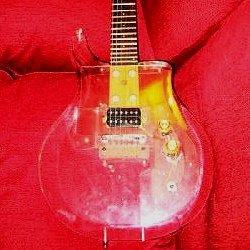
|
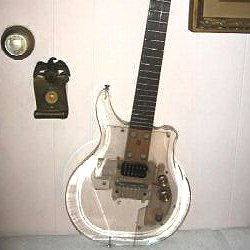
|
Please don't do this to your Dan Armstrong instrument. Above left, this guitar has been modified in so many ways that
it is difficult to begin describing it. In addition to the lower body horn being removed, the instrument now features
a humbucking pickup, Tuno-Matic style bridge, some form of stop tailpiece, along with massive amounts
of routing in the body. The switch has been removed from the guitar's circuitry, and the volume and tone controls have
been relocated on the extra large clear scratchplate of which can be seen better at the upper right.
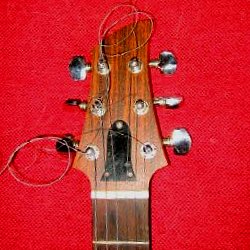
|
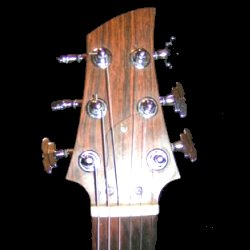
|
At upper left, the headstock on the guitar shown above has a slight modification as well. As can be seen it now has
a Gibson style bell shaped truss rod cover, while the headstock shown in the upper right has its tuners changed out.
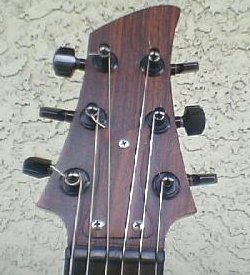
|
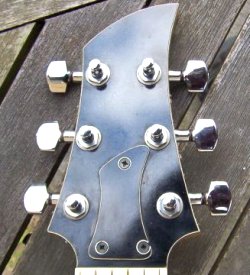
|
The neck & headstock at left has been altered by adding a darker nut, probably Tusk - while the headstock sports dark tuners to match. The
headstock shown at upper right (which can also be seen in the guitar section) has had the wood grained Formica veneer replaced with black
aluminum with white trim. Black screws on the matching truss cover complete the look.
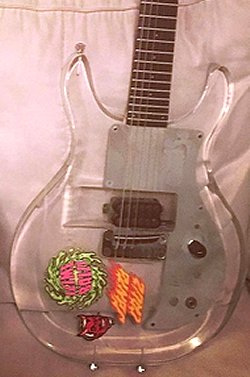
|
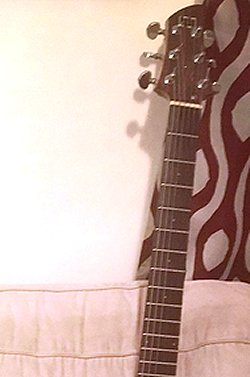
|
A Dan Armstrong that's had the scratchplate replaced with what looks like an aluminum plate. What looks like a Seymour Duncan Invader
humbucking pickup is mounted to the body; its cable going off to the right. A single chrome plated knob and output jack is all that adorns
the plate. Three decals on the body complete the look. At right, the neck looks unmolested with the exception of some design at the top
of the headstock.
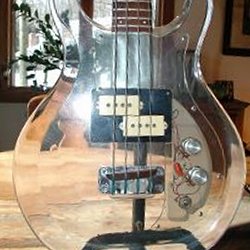
|
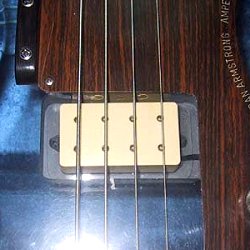
|
At upper left, Precision Bass> type pickups with a black trim ring, coupled with a clear scratchplate
makes a mess out of this bass and makes it impossible to put back to original. At upper right, a more cleaner approach
is to encase a pickup in epoxy that will seat into the present cavity on the bass. In this way, it is an easy task
reverting the instrument back to original.
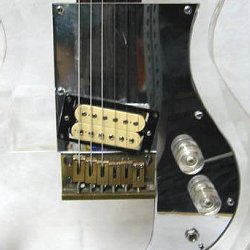
|
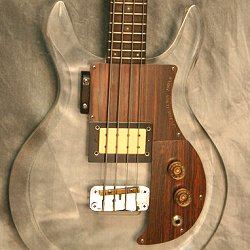
|
Upper left, notice the adjustable Tele like tailpiece screwed down on the acrylic as well as a
humbucking pickup, complete with ring in a slanted position across the strings. The chrome plated scratchplate lacks a
switch, and has two clear, speed type knobs installed. Notice how the scratchplate has been cut out like one would expect,
(with the pickup to be straight). It would appear the pickup had been slanted after the fact.
At upper right, a bass sporting a humbucking pickup with what appears to be a home made mounting ring is screwed down
into the acrylic body of this bass. The rosewood bridge has been replaced with a metal bridge that is secured in place
with two mounting type screws running through it, while the bottom half of the scratchplate appears to have been
broken off completely and has since had a replacement half installed. Gold speed type knobs complete this mod.
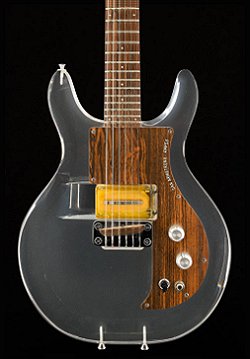
|
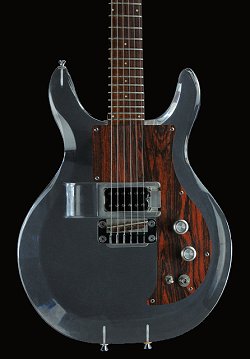
|
At left, what looks like an original Dan Armstrong pickup (given the bar pole piece) that has been rewound and encased in clear
acrylic (as the pickup bobbin is easily visible). Notice the replacement black plastic 3-way selector switch. At right, roughly
the same thing only with a Gibson style humbucker.
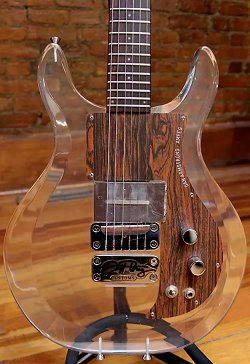
|
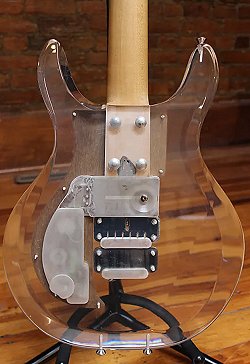
|
At left, what looks like an original Dan Armstrong guitar with a chrome plaque behind the tailpiece. However, upon closer examination I discovered
that there is no sweeping scoop in the body for interchangeable pickups. It was then that I realized that this was originally a bass model that had
been converted to a guitar. Notice how the scratchplate curls around the pickup - indicating the scratchplate is from the guitar model.
At right, and seen from the backside, the plaque is nothing more than a cover placed over the original bass tailpiece. Notice the routing of the
control cavity as seen from the backside as the three pickup threaded lug screw holes that connect the bass pickup to the controls can be seen. Notice too,
a guitar pick is being used as a neck shim. A pretty common practice back in the day.
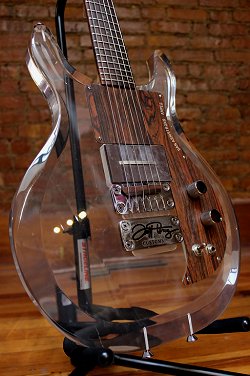
|
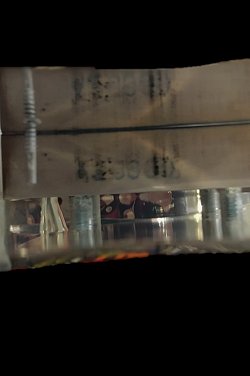
|
At left, and seen better in the enlarged view, a CT pickup is being employed as apparently work had been done under the scratchplate to allow
for the pickup wires to be soldered to the two male type banana plugs so that the CT pickup can be used. Notice too the routing in the acrylic
body for the ball-end of the strings can be seen just under the plaque as the original screws and studs were used. Lastly, the original knobs
have been replaced with aluminum speed type knobs.
At right, and from what I can decipher a neck was likely purchased from Lou Rose Music and installed onto a bass body. From what I can make out
the serial number appears as A2366D but I can't be totally certain. I'm guessing the body was also acquired from Lou Rose as the bass body lacks
the two holes for the thumb rest.
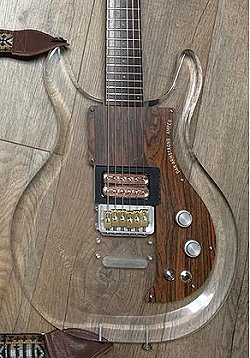
|
As seen at left, another bass, or at least a bass body.... that's been converted to a guitar model. As seen in the Hardware section of this site
it must be remembered that in the case of the acrylic body there is very little difference between the guitar model and the bass model. The only
difference is the location of the tailpiece and pickup, plus the screw holes for the thumb rest.
As such, an original Dan Armstrong · Ampeg guitar scratchplate will line up, and thus cover up every routed cavity of the
bass body - even the holes for the scratchplate screws will line up, as will the carriage bolt holes for the guitar neck.
Seen here, an original Dan Armstrong guitar neck and scratchplate was aquired. Then a tunable bridge/tailpiece and humbucking pickup
was acquired and wired in. The hole in the scratchplate for the pickup selector switch has been covered with a dressing type cap. Notice the
original routing and drilled/tapped holes for the bass tailpiece as well as the lack of the sweeping pickup scoup in the body. I'm guessing the
body was also acquired from Lou Rose as the bass body lacks the two holes for the bass thumb rest.
|
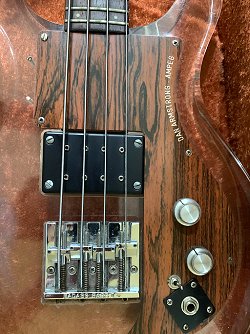
|
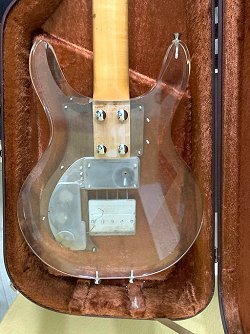
|
At left, an early bass with a serial number of D595A is fairly modified. Immediately noticeable is a Gibson EB-3 humbucker replacing the
original. Pole pieces have allen type heads. The pickup is mounted to the body by four straight slotted head screws. Back of the pickup lies
a chrome plated Badass tunable bridge. In addition, the usual breakage around the output jack is braced up by what looks like a Les Paul
style output jack secured to the scratchplate with screws. Above it lies a mini toggle switch. Being an early model, this bass had no switch
originally. Given the dual row of pole pieces, thus coils, would seem to suggest that the switch is for coil splitting or phasing. Notice at
upper left a straight slotted screw helps secure down the scratchplate. Looks like the frets could use a good polishing.
But the real surprise is the scratchplate itself, as the lower portion seems to have a considerably darker tint to it. I've never seen
this before on any model so my suspicions were up. But upon looking much closer at the white 'Dan Armstrong · Ampeg'
lettering it all appears to be correct and unmodified. On the right, and seen from the back, the screw mountings of the pickup and bridge
can be seen.
At left, the bass rests in an unknown replacement case. Notice the thumb rest is missing. On the right, replacement tuners adorn
the headstock which features the early, smooth-surfaced faux-wood veneer.
Above is a 1970 bass that's been modded with the installation of a Gibson EB-3 humbucker. Seen better in enlarged view, you'd think
they would have chosen better, cleaner and more styled screws than those rusty straight slotted screws to secure the pickup in place.
Notice from the backside the lack of a thumbscrew. Also notice a shim under the tongue of the neck to tilt the neck for better action.
Allegedly, the rosewood bridge saddle is a replacement, though it appears to be an original Dan Armstrong · Ampeg
replacement. Another mod is the addition of pearloid cross inlays on the fingerboard. Controls include a master volume pot, master tone pot,
and 2-way mini toggle switch for coil tapping. Two strap buttons have been replaced.
A bone nut has replaced the original while a set of larger Schaller tuners have been installed.
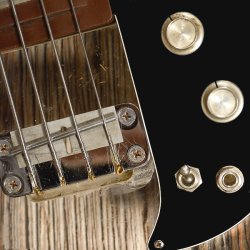
|
Seen here, is a different sort of mod. The mod is a black scratchplate that has since replaced the original, no doubt as a result of the
bassist stepping on his patch cord. But the real attention getter is a round metal rod, of sorts that has replaced the rosewood saddlepiece.
Likely it's probably as good as a fret on a rosewood saddle as far as intonation purposes goes.
|
continue
menu
Names and images are TMand © Dan Armstrong / Ampeg. All rights reserved.
All other names and images are TMand © of their respective owners. All rights reserved.
|
| |

